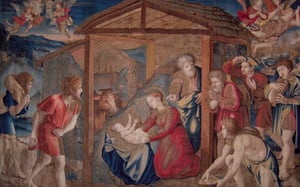Swaddled tightly beneath a star-blanketed Bethlehem sky, God breathed with gentle power. The acceptable time had come. The prophecies were now—at last—fulfilled. The Creator had “entered” creation on a mission of love, and for the next three decades, peace and joy were inhaled and received in tangible new ways.
That Christmas night, the divine life of God was communicated through a tiny human breath. Put simply, God breathed not solely so that he might live but that we would.
It’s fascinating how something so small like a breath forms the line between life and death. The Latin word for breath inspirare is where we get the term “inspiration;” it literally means, “to breathe [life] into.” Inspiration, however, is far more than a biological word or concept, it is a deeply spiritual reality. God’s inspiration animates our Christian souls, guides our steps, and offers us both a mission and a purpose.
We often talk about how the Bible is the “inspiration”—the breath—of the Holy Spirit; how the Word of God was recorded through the pens of men. But, have you ever stopped to consider how vital this inspiration of God is to our faith and, indeed, our lives as Catholics? The Church is inspired, the sacraments are inspired and—with any luck—with every encounter we witness on the pages of Sacred Scripture, we, too, are inspired. We breathe in God’s life (grace) not that we would hold it in, but that we might share it.
Inspiration leads to respiration.
Since you began reading this, you’ve probably taken between twenty and thirty breaths. We know, of course, that inspiration is not only vital for our bodies but also for our souls. It’s when we realize how desperately we need oxygen that we come to appreciate it more.
It’s how our story began, after all (or, “before all” if you want to get technical). Life began because God spoke; he breathed the Word (Genesis 1:3) and creation spun into existence. It was when God breathed life into Adam, however, that things got even more interesting (Genesis 2:7): creation now bore the ability to inspire, to procreate life in God’s image. And at that very first Christmas, beside that majestic manger, the new Adam was swaddled tightly by the new Eve. Heaven breathed. God had drawn near in an even more intimate way than in Eden. The Savior’s exhale announced the coming Kingdom. Heaven came to earth to bring earth back to heaven.
As your eyes take in the crèche this year, allow the Holy Spirit to inspire you, again. Gaze upon these incredible figures immersed in the beautiful reality that is our Christmas story. Ponder these realities in your heart as the Blessed Mother did (Luke 2:19). Consider what each character represents and how they were led to this holy night—heroic characters, timeless tales—all immersed in heart-stopping and soul-stirring moments beside the manger. How ironic that the reality of the Christmas story brings us life by taking our breath away.
As you look forward to the Christmas season, recall your own journey that brought you to this place. For just as the light increased within our Advent wreaths each week, the Light now enters to eclipse the darkness of our world, our homes, and our hearts. Throughout this past Advent season the daily readings reminded us that life’s greatest blessings are often born out of its greatest struggles. For those souls reading this who feel immersed in stress, loneliness or darkness this year, especially, remember now that our Emmanuel has come, “God is (indeed) with us” (Matthew 1:23).
At first glance, Mary’s experience of Christ’s birth seems to be shrouded in more darkness than light. Consider these moments from St. Luke’s Gospel: A teenage virgin is pregnant, but not with her husband-to-be’s child. The girl then leaves home for three months; later, in her third trimester of pregnancy, she leaves home again and travels roughly ninety miles by donkey. She gives birth in a cave and, soon after, hears from a prophet that both she and her child will suffer greatly. Most people would not consider these mysterious moments very “joyful.” Prayerful reflection on the mysteries, however, reveals a cause for intense joy. God was on a rescue mission to save us, and that mission included courageous souls fighting through incredibly challenging situations. Not only do the Joyful Mysteries walk us more deeply into the conception, birth, and childhood years of our Lord Jesus, but they also reveal to us a God who is madly in love with us, a God who will stop at nothing to save all of us from sin and death.
The Christmas mystery—the mystery of the Incarnation—invites us to active prayer. God emptied himself and took on flesh. This is beautiful, not only because of the humility and gentleness of the baby in the manger, but because of his invitation to interact with him physically and intimately. The entire Nativity scene is a celebration of God’s love for his children; his willingness to stop at nothing to ensure our salvation. It’s a scene that we must prayerfully engage in, not just passively “admire.” Never forget that the Lord didn’t come to be admired but worshipped. We should fall on our knees this night, as they did so many centuries ago, breathe in his peace and joy, and worship the God who loved us enough to be born into the world’s brokenness and sin to save us from it.
This article was originally published on the Ascension Blog and written by Mark Hart. Republished with permission.
